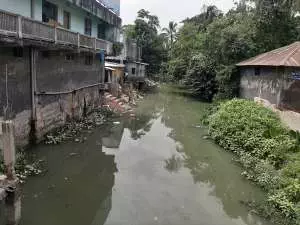Barishal is one of the divisions of Bangladesh that is situated in the southern part of the country. Most of the area of the division is covered by rivers, canals, and ponds. So the scarcity of water in this area is not so high. But nowadays pure water for household activities and drinking water scarcity often is found. In this article, We are going to discuss the present condition of a canal named “Jail Khal” in Barishal City Corporation (BCC) that passes away from Zia Sharak to Notullabadh area. It also covers some other areas as well. This canal was not only a great source of pure water for household activities but also a great source of foods e.g. different fishes. Many ponds were joined with this canal and the ponds also abounded of diverse fishes and other aquatic organisms. Nearly 15-20 years ago this canal was a great source of natural resources. Afterward, it started to become polluted over time due to different kinds of human activities.
The present condition of this canal cannot be described shortly. The canal is polluted unexpectedly day by day. The bad odor of water is felt by people when they pass through the road. Water level decrease gradually. From November to May decreasing water levels can be found mostly. As a result, many problems can be observed in local people. Most of the poor people suffer from pure water for household activities they depend on supply water. The amount of supply water is not enough to fulfill their demand. Bad odor of water causes a health problem as well. They cannot breathe easily. Mosquito, fly are increasing at an alarming rate. People use coils during day time that can cause heart disease. There are many effects of the water pollution of the canal on the economic status of the local individuals.

People can not get fresh fish from the canal. This environment is very difficult for the survive of aquatic animal. Boatmen loss their work, the vegetable seller cannot transport vegetables in the waterway that is actually a cost-effective transport system. They depend on highway transportation through vehicles that are so much costly. Water pollution problem of “Jail Khal” not only affects human life but also there are many effects on vegetation and indigenous animals. Polluted water of this Khal does not limit in its own place, it enters into the food chain. Duck, Hen, Goat often eat hop, celery that’s been contaminated by polluted water. They also consume health hazardous materials into their body.
This situation is the result of illicit activities of local powerful people. Some house owner uses this canal as a drain, the household wastes are dumped in the canal. Polythenes are also thrown repeatedly by the people of all age. These are the main causes of water pollution in this canal. This problem is spread to the soil, air and food chain as well and that is also a threat to the local biodiversity. Finally, it can be clearly said that it is high time to reduce the rate of pollution from this canal. If the pollution rate can minimize, this canal could be a precious natural resource for the dwellers of the Barishal City Corporation. The water flowing pattern must not be hindered by different abstruse activities. Unwanted dumping materials should not throw in the water body and maintain a strict rule in this regard. It can be a recreational area if the pollution can be mitigated by the Barishal City Corporation (BCC). If it does not take as a serious issue at this moment, after 10-13 years it can stand out as an acrid phenomenon for the people of the area. The policymakers of the Barishal region should consider the issue as an intensive issue. Proper planning, caring as well as actions can be helpful to mitigate the dangerous environmental problems. We the general people of the area should also be admonished regarding the environmental apocalypse.
References:
- Curriero, F.C., Patz, J.A., Rose, J.B., Lele, S., 2001. The association between extreme precipitation and waterborne disease outbreaks in the United States, 1948–1994. Am. J. Public Health 91, 1194–1199.
- Maybeck, M., 1982. Carbon, nitrogen and phosphorus transport by world rivers. Amer. J. Sci. 282, 401–450.
- Rigler, F.H., 1973. A dynamic view of the phosphorus cycle in lakes. In: Griffith, E.J., Beeton, A., Spencer, J.M., Mitchell, D.T. (Eds.), Environmental Phosphorus Handbook. John Wiley & Sons, New York.
- Smith, J.E., Perdek, J.M., 2004. Assessment and management of watershed microbial contaminants. Crit. Rev. Environ. Sci. Technol. 34, 109–139
Author:
Sabekun Naher
Soil and Environmental Sciences,
The University of Barishal,
Barishal, Bangladesh.